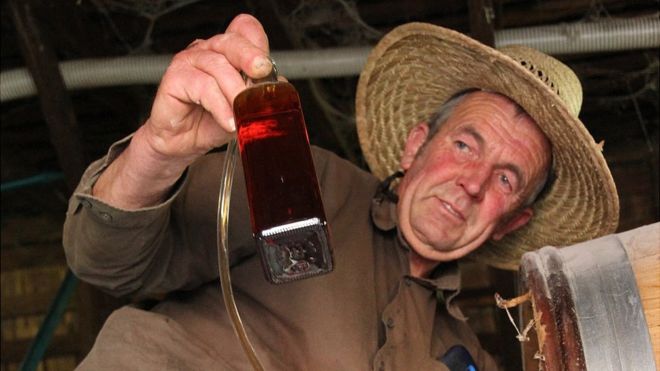
Just near Bagdad on the road to Jericho in Australia's island state of Tasmania, Peter Bignell is making "liquid gold".
But whereas many other whisky producers use an internal element to heat their stills, the ecologically minded artisan fires his with used cooking oil reclaimed from a local chip fryer.
"With the odd chip strained away, she burns a beaut," he says amid the bald hills of the Tasmanian Midlands.
"The direct-flame heating of the still [produced by burning the oil] lends a caramel to the spirit."
That's the not the only piece of unusual equipment in Bignell's still.
He uses a reclaimed laundromat tumble dryer for malting. A repurposed motor from a blender acts as a pump amid a marvellous collection of reused bits and pieces that make up his Belgrove Distillery, crammed into a converted, cobwebbed 18th Century stable.
Tastings take place in one of the stalls before an order is siphoned from a barrel overhead into a bottle that's numbered, signed and labelled before your eyes.
Bignell, an agricultural scientist cum sand-and-ice sculptor of world renown, is committed to locally sourcing his ingredients.
He is even considering using sheep manure from under his shearing shed as an alternative to peat, which is burned to impart a smoky flavour to the whisky.
"It's less 'miles' as the shed's next to my rye fields, but I'm worried about a possible marketing downside," he says.
Peter Bignell with the repurposed dryer he uses in the malting his high-quality whiskiesImage copyrightPaul Carter
Image caption
Peter Bignell with the repurposed dryer he uses in the malting his high-quality whiskies
Biblical proportions
Not that he need worry.
With a rating of 94.5 out of 100, his rye whisky rates as "liquid gold" in the world's leading whisky guide, Jim Murray's Whisky Bible.
"Perhaps the most concentrated rye arrival I have tasted for a couple of years from any part of the world. Just so sharp, almost three dimensional," Murray's review gushes.
No less a figure than Rene Redzepi, the chef who runs fine-dining mecca Noma in Copenhagen, is a fan of Bignell's unique whiskies.
Noma's newly opened Sydney pop-up restaurant has five Belgrove whiskies on its list of 23 Australian craft spirits.
Bignell says he is "pinching himself" and plans on tripling production with a larger second still to 300 litres per month.
"But I've been saying that for a couple of years," he says.
Signed bottle of Belgrove Distillery's whiskyImage copyrightPaul Carter
Image caption
Belgrove Distillery is part of a high-quality whisky movement based out of Tasmania that is gaining a global reputation
Why is whisky booming in Tasmania?
Photo shows interior of Overeem DistilleryImage copyrightOvereem Distillery
Image caption
Old Hobart Distillery is one of the premium producers of whisky in Tasmania
Tasmania looms large in Australia's history of distilling.
When the state was still a colony called Van Diemen's Land, its fourth lieutenant-governor, Sir John Franklin, passed a law banning small pot stills in 1838.
A trade in "rum" was undermining the fledgling colony, Sir John thought.
When the Australian states federated in 1901, "Bad Frankie's" law passed through to all of the country, although stills above 40,000 litres were permitted.
Enter lauded Tasmanian Bill Lark, a surveyor, who set about changing the law and pioneering Australian craft whisky.
On a fly-fishing trip to the Tasmanian highlands he thought the state would be a good place to make whisky.
He successfully lobbied politicians to allow the running of stills under 40,000 litres in 1992, and went on to set up his own distillery in Tasmania.
Not enough of a good thing
Demand for Tasmanian whisky was turbo-charged in 2014 when Tasmania Distillery's brand Sullivans Cove won "World's Best Single Malt Whisky" at the World Whisky Awards.
It was the first time a whisky from somewhere other than Scotland or Japan had won the prestigious award.
Now the 15 or so small-scale distillers in Tasmania can't make enough to keep up with demand and their small stockpiles have been exhausted.
While the number of barrels maturing in Tasmania is increasing each year, Tasmania's makers of "liquid gold" must manage waiting lists of up to two years for certain barrels.
That's something Tasmania Distillery laments, as 700ml bottles of Sullivans Cove now trade privately for $6,000 Australian ($4,200;£3,000).
The whisky, which was aged in a French oak barrel, was selling for A$180 before the award and the subsequent stampede to secure them.
The distillery didn't think, pre-award, to hold any back, leaving them with only a couple of bottles and a small reserve.
"We won't do that again," says marketing manager Bert Cason.
Tasmania Distillery was last year able to produce two special release magnums using just a blend of the "world's best" barrel, selling them within minutes of release for $10,000 each.
A step up in production sophistication from the likes of Belgrove, Tasmania Distillery makes 8,000 bottles a year of the French oak (now $350) and 18,000 bottles in total of all types of Sullivans Cove whisky.
Old Hobart Distillery manages demand by allocating "a significant number" of bottles from each barrel to specialist bars, restaurants and liquor stores, marketing manager Jane Overeem says.
"The remainder is allocated to our customers who have joined our mailing list.
"Just before Christmas, we released three barrels online after sending an email notification to our very loyal database," she says.
"The three barrels sold out in 21 minutes."



No comments:
Post a Comment